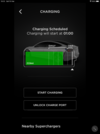never saw any range change when others were reporting increases to 322/325 via software changes.
I wouldn't use that to necessarily conclude you have a fixed 72.5kWh pack. The 310->325 was an unlock of capacity - to those who had it available.
Given the degradation you've seen, you could well have had more than 5% capacity loss at the time of that update, so you may have had some unlock but not enough to bring you above 310. You would know best what you saw (it's really unclear exactly how this worked for individual owners and why).
For example, you may have degraded to 294 miles at 100% at the time of the update...and then you would have increased to to 309 miles with that update (a 4.8% capacity unlock). If you use TeslaFi or similar you might be able to see the change. Or you may have your own records. Or there may have been no change at all, as you said.
A 294 mile to 309 mile change is the same as the change for an owner seeing a 310 to 325 miles increase. But I am aware of some reports of owners who didn't see any apparent step change (no matter what the specific numbers were)...not sure if this was for very early VINs, or what.
But what Tesla uses for warranty purposes for your specific vehicle which was sold as a 310-mile vehicle? I don't know...but I would assume 72.5kWh...which would mean 217 miles, or 50.8kWh (which I believe is actually a 35% capacity loss).
In the EPA testing, Tesla extracted 79.3kWh (for "reasons" this would show in SMT as a 77.8kWh Full Pack When New, I believe) from the Model 3 RWD battery, FWIW. In the first round of testing (310-mile edition), they extracted 75.7kWh. But the core issue is: was there actually any difference in these packs?




